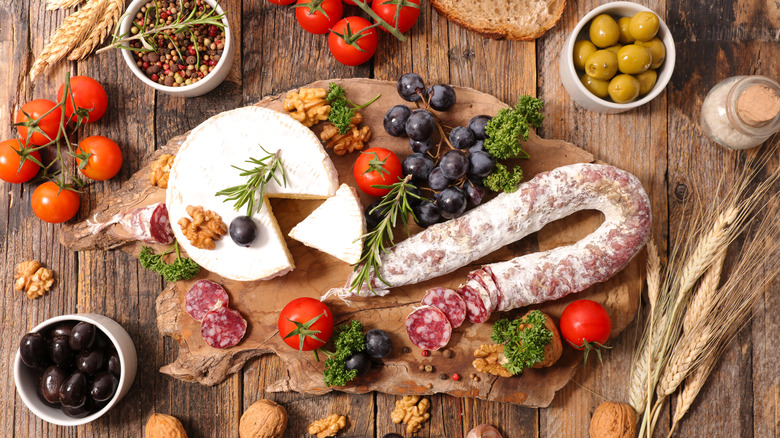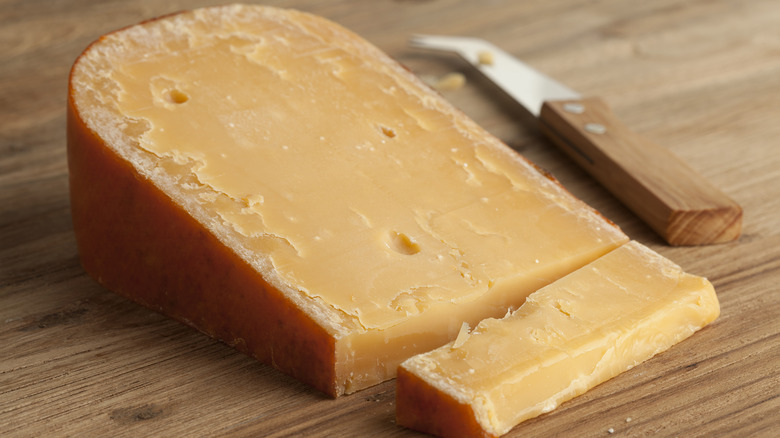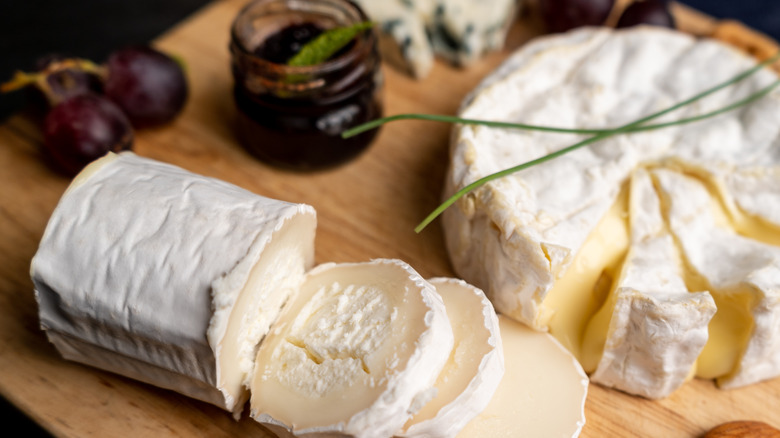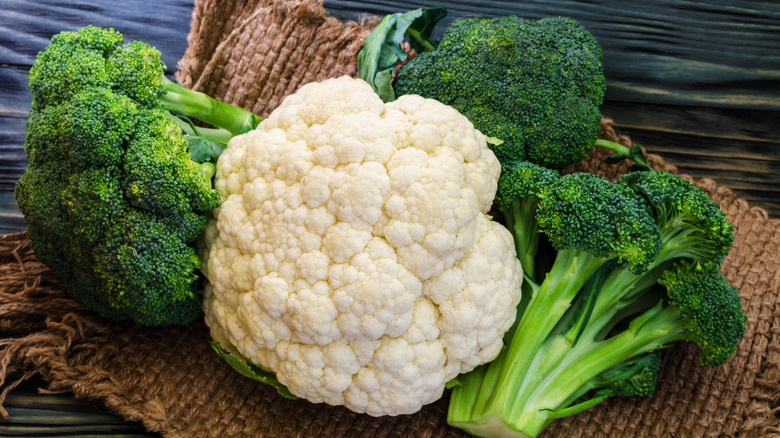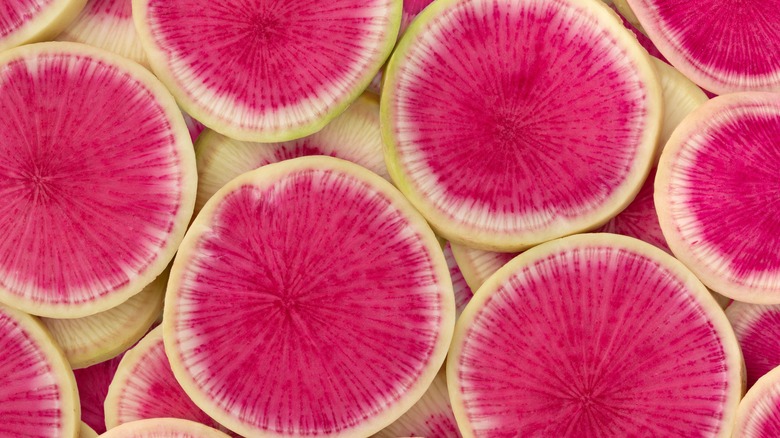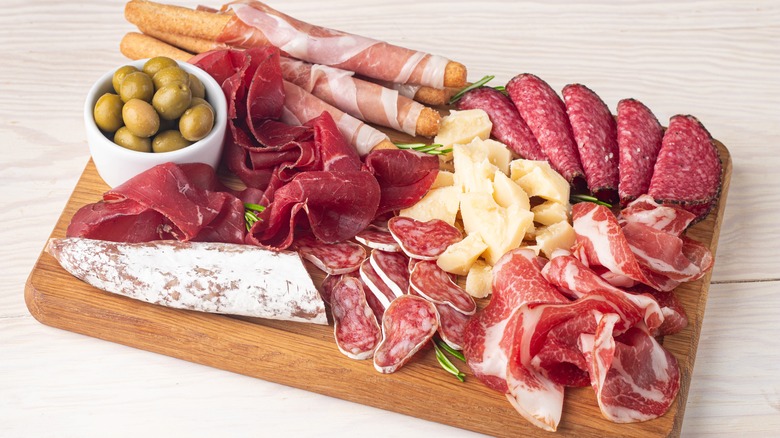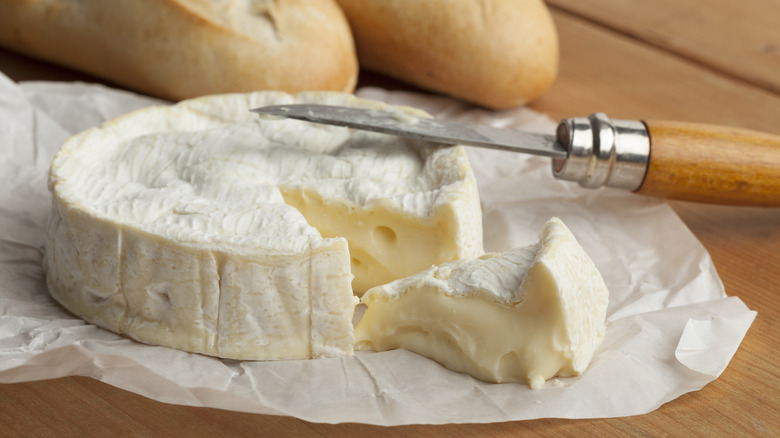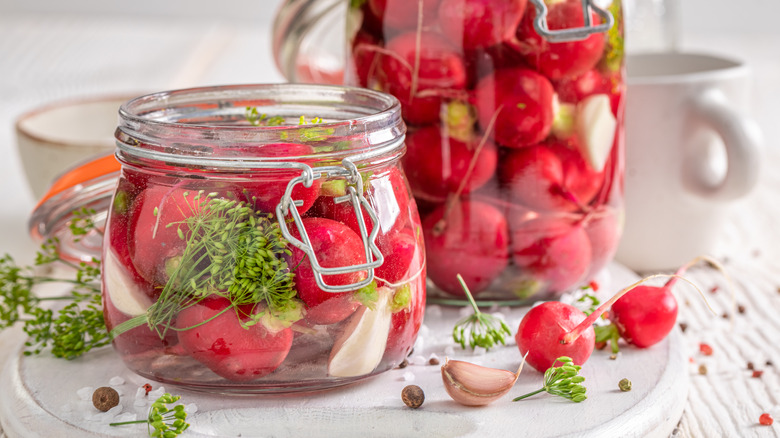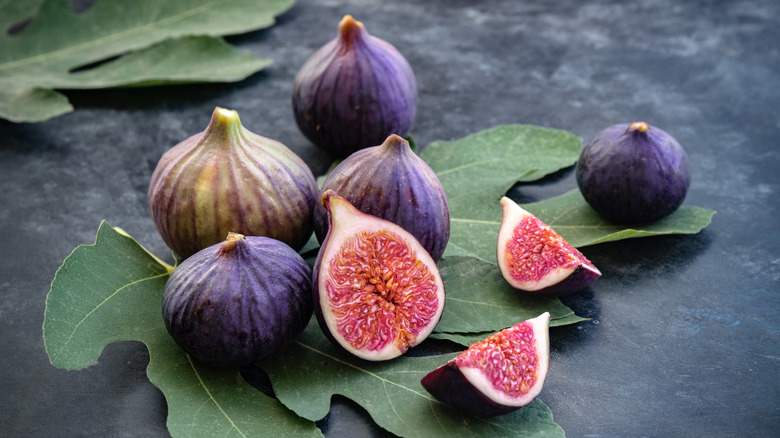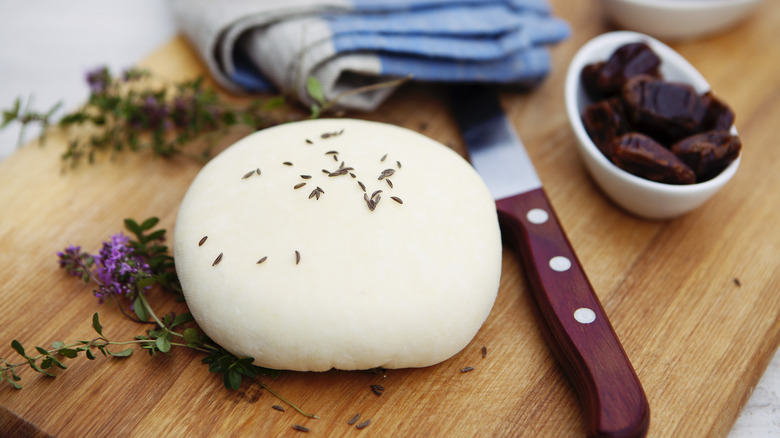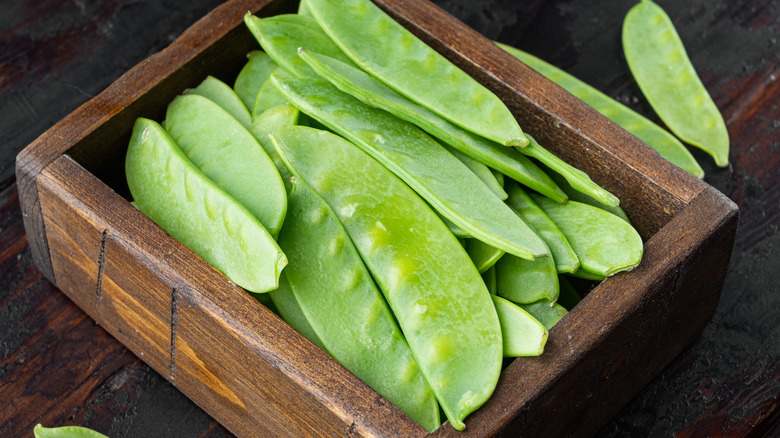10 Boring Charcuterie Ingredients (And Expert Suggestions To Replace Them)
There's a reason why charcuterie boards are so popular. When you're hosting an event, be it a formal gathering or a casual picnic, charcuterie boards are the perfect way to sate your guests' appetites without serving a full meal. They're also pleasing to the eye and they provide ample room for creativity and experimentation. No two charcuterie boards need to be the same; you can mix and match depending on your favorite cheeses, veggies, fruits, and meats.
While the possibilities are endless when it comes to charcuterie boards, there are items that seem to pop up on every platter — and not because they're anything special. From mediocre cheeses to dry crackers, some additions are starting to feel a bit boring after being added to every charcuterie board under the sun for too long now. The good news is that for every passé charcuterie item, there are delicious, unique replacements, like a good Vermont Camembert instead of the overused Brie cheese or aesthetically pleasing pickled radishes over inedible decorative flowers. If you're looking to upgrade your charcuterie boards, try these expert-recommended replacements for boring ingredients.
Replace smoked American Gouda with a smoky Danish cheese
Gouda, which originated in the Netherlands, is a cheese with pros and cons. And while it is a popular addition to charcuterie board spreads, HappyBoards co-founder and chef Nelson Cienfuegos explained why he's "never been a fan" of Gouda cheese that is manufactured in America.
"I would say that smoked cheeses, like generic smoked Gouda, I think that's 100 percent a no," the charcuterie expert told Chowhound. His reasoning? The smoky flavor and smell of American-made Gouda are produced artificially with chemicals. "It's really not something that I would ever recommend to anybody, doing smoked Gouda," he said.
Instead, Cienfuegos suggested trying a good smoked Danish cheese, and purchasing it at a local cheese shop rather than buying from the grocery store. "They always carry some amazing stuff," he said. "You can absolutely go with something that has a little bit of smokiness [and] can just as easily get something that's beautiful local or even from Denmark."
Replace store-bought infused goat cheese with fresh goat cheese and jam
Grocery chains, including Trader Joe's and Whole Foods, sell goat cheeses infused with berries. While that might sound like a deliciously tempting way to incorporate both cheese and fruit into your charcuterie board with just one purchase, Cienfuegos advised against it.
"A lot of these places, they're using syrups and then they throw in dehydrated fruit and call it infused goat cheese," he explained, noting that this results in cheese that is high in fructose and high in sugar. "It's not very healthy for you," he said.
According to Cienfuegos, it's better to buy your goat cheese and fresh jam separately and then make your own infused cheese. "You buy a plain goat cheese, you buy some nice jam that you know is made from scratch from an artisanal chef or a store that you trust, and then you can easily just grab a fork, mash it in, and then whip the jam right inside," he said. "And then you have your own personal goat cheese. You'll know exactly what's in it instead of all this sugar that they're adding in."
Replace crumbly crackers with sturdy veggies
Some people might find it hard to envision a charcuterie board without crackers, but there are better ways to get more texture and flavor out of the vehicle you use for your meats and cheeses. "A lot of people want to be healthier now ... [so] they get gluten-free crackers," Cienfuegos said. "Well, knock all that out of the way and use vegetables that have that beautiful crispness to them, and they're healthy and good for you." His top recommendations are raw broccoli and cauliflower.
If you're not ready to get rid of crackers altogether, though, opt for a thin, baked cracker instead of the crumblier butter cracker. And, hard as it might be, resist the urge to overcrowd your board with saltines, Ritz, crostini, and Wheat Thins. Edit Littvan, owner and kitchen manager of Jadis, a New York City wine bar that specializes in customizable charcuterie boards, believes less is more. "What blows me away is how charcuterie and cheese platters really became like a circus," she told Chowhound. "You don't have to do this elaborate all-crazy platter. One type of cracker is enough."
Replace traditional radishes with watermelon radishes
People understandably want their charcuterie boards to be photo-worthy, but that sometimes means including aesthetically pleasing ingredients that don't get eaten. One such item is radishes, which offer a stunning pop of color but aren't everyone's cup of tea. "I've seen so many times that people at events, they see [the radishes] and they're like, 'Oh, my god, it's so beautiful,' but at the end of the night, all the radishes are still there," Cienfuegos said. "They're forgetting how amazing these radishes are, that crispiness, that little sharp kind of spiciness that you get at the very end."
Noting that we eat with our eyes first, Cienfuegos said that even people who think they don't like radishes will want to try the stunning watermelon variety of the root vegetable. They are milder in taste and, with their "gorgeous pink interior," particularly pleasing to the eye. "I slice them thin enough that you can use them as a carrying vessel," he said. "You grab a slice, you put your meat on top, you put your jam, you put your cheese and whatever else you want, and it becomes your own personal cracker, but healthier," he said.
Replace grocery store meat with local meat shop selections
Although the term has come to be associated with cheese and veggie boards, the French word "charcuterie" actually refers to prepared meats. So, it stands to reason that you should take special care with the meat you select for your platter. From salamis to beef cuts, charcuterie boards are all about the meat. Cienfuegos recommended shopping locally to get the best quality selections. "If you don't know where your local meat shop is, you need to find it," he said.
Cienfuegos also suggested thinking beyond the meats that everyone is used to seeing on charcuterie boards. "Prosciutto's a huge one, everybody loves some prosciutto. But then we forget about smaller items," he said. "There's so many good chicken sausages out there now if people don't eat pork. And bresaola, it's kind of like prosciutto, but it's beef. It's kind of like A1 Wagyu."
A cut of meat from a local butcher is going to be fresher than the pre-packaged offerings at the grocery store. And while you may pay a little bit more for the increase in quality, Cienfuegos thinks it's worth it. "You may spend a little bit more now, but you're gonna enjoy so much healthier food in the long run," he said. "So, I feel like it balances out."
Replace Brie cheese with goat Brie cheese or Camembert
Many people's minds go straight to Brie when they think of a spreadable cheese. But Littvan challenges people to leave the Brie to use on garlic bread and step up their soft cheese game for their charcuterie boards. "I go out of my way to always get goat Brie cheese," she said. "It elevates the regular Brie cheese to the next level."
Praising its creamier texture and increased flavor profile, Littvan said goat Brie cheese is also becoming easier to find in stores. "I have seen it lately, Trader Joe's started carrying it. I always see it at Whole Foods. A year ago it was hard to find, there's more of it right now," she said.
If goat Brie cheese isn't your thing, there's also Camembert, which Littvan pointed out isn't always as stinky as people think. "Vermont has some mind-blowing Camembert," she said. "If you wanna get that Camembert everybody eats that's mild [and not] too pungent, try an American Camembert. You're gonna be blown away, especially [if it's from] from Vermont, it's another level."
Replace mini peppers and decorative flowers with pickled radish
Cienfuegos and Littvan both agree that it's time to retire the giant grazing tables in favor of smaller, more thoughtfully curated charcuterie boards. When you have too much going on, you end up with a lot of food waste, especially if you're putting out items that are more for aesthetics than sustenance.
"Funny enough, half of those things you don't even ever eat," Littvan said of huge displays that seem to be more about pleasing the eye than the palette. "You know those mini peppers? Whoever eats those mini cute peppers whole? There's a saying in cooking: 'Only put out things that you eat.' Nothing should be ever on a plate that you don't eat ... like a decorative flower."
Littvan suggested colorful radishes in place of mini peppers and decorative flowers, which usually end up in the trash. Although Cienfuegos noted that some people leave radishes untouched on their plates, Littvan said pickled radishes give guests a different experience than the raw vegetable they're used to. "You know last summer, it was pickled red onion on every platter? Pickle that radish [instead]," she said. "It's so crunchy [and] it cleanses your palate after eating. It's just a fabulous thing, pickled radish."
Replace watermelon with cantaloupe or figs
Watermelon, whether cut into sticks, cubes, or triangles, is a crowd-pleaser, especially on warm days. However, while it might be perfect for picnics and barbecues, watermelon isn't the best addition to a charcuterie board. The juice tends to leak out all over the platter, mingling with the other foods. If you're looking for a fruit that is still juicy and refreshing but less likely to make your charcuterie soggy, cantaloupe or figs are great alternatives.
"Everybody always concentrates this time of the year around the watermelon salad with the feta cheese. People tend to overlook the cantaloupe. It's in season [and is] absolutely delicious," Littvan said, pointing out that cantaloupe also pairs nicely with the saltiness of meat. "[Also] in season right now: fresh figs."
Another reason people tend to opt for watermelon is due to its nice pop of color, but bright orange cantaloupe slices and purple figs with reddish insides will serve the same function. They'll look beautiful, taste great, and you won't have juice running all over your board.
Replace whipped ricotta with whipped goat cheese or farmer's cheese
Who doesn't want a nice creamy cheese on their charcuterie board? If you've stuck with whipped ricotta in the past, consider expanding your horizons with whipped goat cheese or farmer's cheese. "I think whipped ricotta came to an end. I think the whipped goat cheese is having its time," Littvan said. "You can season it up with little crushed hazelnuts, chives, honey, whatever you want to put in it. It's so fluffy and creamy [and] absolutely delicious."
Littvan also recommended farmer's cheese, which she described as a drier version of cottage cheese. "The rinds are much smaller, and it's a really good paste, it's workable," she said. "For charcuterie boards, I would just take the farmer's cheese [and] mix it in with a little bit of sour cream or creme fraiche just to give it a silky texture. And then, again, you can season it up. I season it with paprika, finely chopped red onion, and ground caraway seeds. It's so refreshing."
Replace sliced pears with crisp summer veggies
Pears are a common charcuterie board addition because let's face it, they go great with meat and cheese. However, just like apples, they turn brown quickly once sliced, which makes them less appetizing when they've been sitting out at an event for a while. If you want to provide a refreshing respite from the meats and cheeses on the platter, opt for veggies instead of pears. They'll stay looking fresh for hours on end.
"I do think this whole slicing pears and cucumber cute and all this stuff is over," Littvan said. "I would concentrate on sugar snap peas — they're crunchy, just cut them in half, let the peas show, they're super cute." She also recommended endives and fennel. "These veggies are summery, refreshing, and crunchy. They can take the heat if your charcuterie board is out for a while."
Charcuterie boards are more popular than ever, but that doesn't mean you have to follow trends that include boring ingredients. By replacing the overdone staples with these inventive, delicious alternatives, you're sure to assemble a platter that stands out amid a sea of charcuterie boards.
